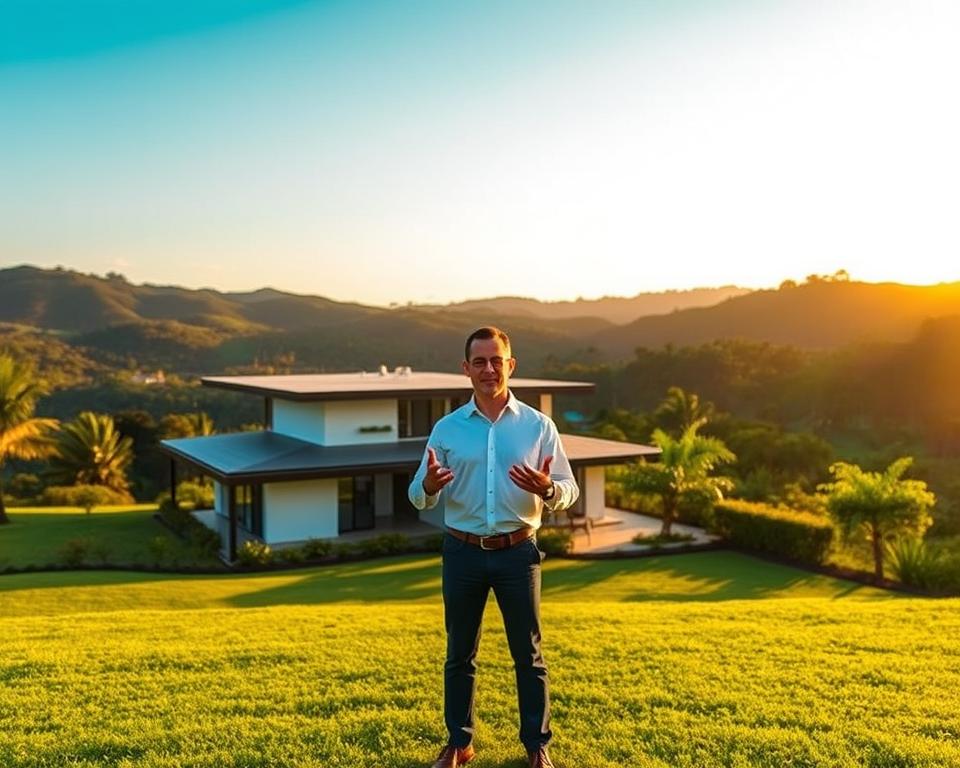Real Estate Analytics in Costa Rica: Our Expertise
At Gap Real Estate, we simplify buying, selling, or investing in Costa Rica’s thriving property market. With over two decades of coast-to-coast experience, we deliver seamless transactions through expert guidance and clear communication.
Costa Rica’s real estate market is entering 2025 with significant momentum, driven by increasing demand from international buyers and the global shift toward remote work. Recent reports suggest that property prices in key coastal regions are expected to rise by up to 8 percent this year alone.
Our comprehensive real estate analytics provide valuable insights for investors, buyers, and sellers, helping them make informed decisions in this dynamic market.
The Current State of Costa Rica’s Real Estate Market
As we analyze the Costa Rican real estate market in 2024, we observe a complex interplay of trends that are reshaping the industry. The market has seen a 10% drop in transactions compared to 2023, yet properties are selling faster, with the average time on the market decreasing by 33% to 395 days.
Key Market Indicators for 2024
The current market indicators reveal a nuanced picture. Property prices in Costa Rican city centers range from $500 to $1,300 per square meter. In areas like San José, houses average around $1,110 USD per square meter, while condominiums can reach $1,724 USD per square meter.
- The Costa Rican real estate market in 2024 is complex, with a 10% decrease in transactions but a 33% faster sale rate.
- Property prices vary, with city centers seeing prices between $500-$1,300 per square meter.
- Regional variations are evident, with the Central Valley experiencing a 13% decline in transactions.

Transaction Volume and Pricing Trends
The market is experiencing a rebalancing rather than a downturn, with increased inventory and faster sales. Single-family home inventory has risen by 24% nationwide, giving buyers more options. Pricing trends show significant differences between urban and coastal properties, with luxury homes in Guanacaste experiencing a 31% price decrease.
- Single-family home inventory has increased by 24% compared to 2023 levels.
- Luxury homes in Guanacaste have seen a 31% price decrease, averaging $1,737,732.
- The market favors well-informed buyers due to increased inventory and efficiency.
Regional Analysis: Where Investment Opportunities Shine
As we explore Costa Rica’s diverse real estate landscape, regional variations reveal unique investment opportunities. Costa Rica’s property market is characterized by distinct regional dynamics, each offering different benefits for investors.
Guanacaste: Luxury Market Dynamics
Guanacaste’s luxury market has seen significant price adjustments, with luxury home prices decreasing by 31% to an average of $1,737,732. This correction creates potential entry points for investors seeking high-end properties in this popular coastal region.
Central Valley: Stability and Growth
The Central Valley continues to demonstrate stability and steady growth, with property prices ranging from $903 to $1,598 per square meter. Some properties even hit $5,200 per square meter, appealing to both local and foreign buyers.
South Pacific: Emerging Hotspots like Uvita
Uvita leads the South Pacific region, accounting for 37% of recent sales. The area’s commitment to sustainable development and natural beauty drives its growth, making it an attractive investment opportunity.
Real Estate Analytics in Costa Rica: Data-Driven Decision Making
At the heart of our real estate analytics in Costa Rica is a commitment to using data to drive decision-making. We understand that investors and buyers require accurate and timely insights to navigate the complexities of the Costa Rican real estate market.
How We Leverage Market Data
Our approach combines comprehensive market data collection with sophisticated analysis techniques to identify patterns, trends, and opportunities. We track key economic indicators, such as Costa Rica’s impressive 4.0% economic growth in 2024 and projected 3.5% growth in 2025, to understand their impact on property values and investment potential.
Predictive Analytics for Investment Planning
Through predictive analytics, we forecast potential market movements, helping investors position themselves for both short-term gains and long-term appreciation. By leveraging historical data and current market indicators, we provide actionable insights that reduce risk and maximize returns in Costa Rica’s dynamic real estate landscape.
Rental Yield Analysis: Maximizing Your Investment Returns
Maximizing investment returns in Costa Rica’s real estate market requires a deep understanding of rental yield analysis. As we examine the dynamics of rental yields, it becomes evident that Costa Rica presents an attractive environment for investors, with rental yields expected to stabilize at around 6% by 2024.
Vacation Rental Performance in Tourist Hotspots
Vacation rentals in tourist hotspots like Santa Teresa are delivering exceptional returns, ranging from 12% to 17%, driven by a 19% annual increase in tourist arrivals. The growing preference for rental accommodations over traditional hotels has led to a noticeable housing crunch, further boosting rental income for investors.
Long-Term Rental Market Stability
While vacation rentals offer high returns, long-term rentals provide stability, particularly in the Central Valley, where expat communities and business professionals create steady demand. Strategic property selection is crucial, with factors like location, property size, and amenities significantly impacting potential returns.
By understanding these dynamics, investors can make informed decisions to maximize their rental yields in Costa Rica’s diverse real estate market.
Price Per Square Meter: Understanding Property Valuation
Understanding the price per square meter is crucial for accurate property valuation in Costa Rica’s diverse real estate market. The price per square meter varies significantly across different regions, making it essential to analyze these variations for informed investment decisions.

Urban vs. Coastal Property Values
In Costa Rica, urban property values, particularly in San José, exhibit distinct patterns. Houses average around $1,110 USD per square meter, while condominiums can command higher prices up to $1,724 USD per square meter. In contrast, coastal property values typically exceed urban prices, particularly for ocean-view or beachfront properties, due to limited supply and high demand from international buyers.
Construction Costs and Property Development
Construction costs play a significant role in property development and valuation. In city centers, basic construction techniques are affordably priced between $500 and $1,200 USD per square meter. Understanding these costs, along with additional expenses such as permits and professional fees, is crucial for accurate property valuation and informed investment planning.
By analyzing the price per square meter and construction costs, investors can identify potential value opportunities in Costa Rica’s real estate market. Regions with lower prices per square meter compared to comparable areas with similar amenities and growth potential present attractive investment prospects.
Economic Factors Influencing Costa Rica’s Real Estate
As we examine Costa Rica’s real estate, it’s clear that economic factors have a substantial impact. The country’s robust economy is a significant driver of its real estate market stability.
GDP Growth and Market Stability
Costa Rica’s economy is experiencing significant growth, with a 4.0% increase in 2024 and a projected 3.5% in 2025. This growth supports real estate market stability by inspiring investor confidence and boosting property values. Strong GDP growth correlates directly with increased purchasing power among local buyers, while also attracting foreign investors seeking stable markets with positive economic indicators.
Tourism Impact on Property Demand
Tourism plays a crucial role in Costa Rica’s real estate ecosystem. With a 19% annual increase in tourist arrivals, property demand is directly boosted, particularly in popular destinations like Santa Teresa. The tourism sector’s impact extends beyond vacation rentals, creating jobs that increase local purchasing power and stimulate the development of supporting infrastructure that enhances overall property values.
Sustainable Development: The Future of Costa Rican Real Estate
The future of Costa Rican real estate is being shaped by sustainable development practices, driven by government initiatives and investor demand. Costa Rica has been at the forefront of environmental conservation, and this commitment is now reshaping its real estate landscape.
Eco-Friendly Building Practices
Costa Rica’s Sustainable Construction Guidelines, part of its Carbon Neutrality 2.0 Program, are driving the adoption of eco-friendly building practices. By 2026, it is projected that half of new residential developments will incorporate sustainable building practices, reducing energy consumption and environmental impact. Developers are pursuing international certifications, such as LEED and EDGE, with a focus on energy efficiency and environmentally friendly materials.
Sustainability as an Investment Driver
Sustainability has become a significant driver of investment in Costa Rica’s real estate market. Eco-conscious buyers are willing to pay premiums for properties that align with their environmental values and offer long-term operational cost savings. The integration of renewable energy systems, particularly solar power, is becoming standard in new developments, reducing dependency on traditional energy sources and lowering utility costs for property owners.
Foreign Investment Trends in Costa Rica
Foreign investment is a major driver of Costa Rica’s real estate market, with international buyers drawn to its political stability and natural beauty. This trend is supported by Costa Rica’s growing economy, which is projected to grow by 4.0% in 2024 and 3.5% in 2025.
Buyer Demographics and Motivations
The profile of buyers investing in Costa Rica is evolving. Remote workers are purchasing homes that offer reliable internet connections and beautiful surroundings, blending work and lifestyle in one location. According to recent trends, North American investors remain the largest group of foreign buyers, but European and South American investors are increasing their presence, diversifying the market, and bringing new perspectives.
Legal Considerations for International Investors
For international investors, understanding the legal landscape is crucial. Costa Rica allows foreigners to own property with the same rights as citizens in most cases. We recommend that investors explore the legal considerations involved in purchasing properties in Costa Rica to ensure a smooth transaction.
Market Challenges and Risk Assessment
Investing in Costa Rica’s real estate market comes with its own set of challenges that require careful navigation. As investors, we must be aware of the potential risks and challenges associated with property investment in this market.
The Costa Rican real estate market is subject to various challenges, including stringent environmental regulations aimed at protecting the country’s rich biodiversity and natural resources. Regulatory changes can significantly impact property development and investment, as zoning laws, building codes, and environmental restrictions vary by region and are subject to change over time.
Navigating Regulatory Changes
Regulatory changes can have a substantial impact on property investment in Costa Rica. For instance, changes in zoning laws or building codes can affect the value of a property or the feasibility of a development project. To navigate these changes, investors must stay informed about local regulations and work with experienced real estate agents and legal professionals.
Environmental Considerations in Property Investment
Environmental considerations are particularly important in coastal and protected areas, where development restrictions may limit property use or require special permits for construction and modifications. Understanding maritime zone regulations is crucial for coastal property investments, as properties within 200 meters of high tide are subject to special concession rules rather than traditional ownership.
By understanding these challenges and risks, investors can make more informed decisions and navigate the complexities of Costa Rica’s real estate market.
Technology and Real Estate: Digital Transformation in the Market
The digital transformation in Costa Rica’s real estate market is revolutionizing how properties are bought, sold, and managed. This shift is driven by technological advancements that enhance market efficiency, expand accessibility, and provide valuable insights for investors and buyers.
Enhancing Property Experience
Virtual property tours have become essential tools, allowing potential buyers to explore properties in detail from anywhere in the world. This technology significantly expands the market reach for sellers and developers. Additionally, online platforms like Airbnb have significantly altered the rental landscape, enabling property owners to market directly to international visitors and maximize rental income.
Data-Driven Market Analysis
Data analytics tools are transforming market analysis, providing investors and buyers with unprecedented insights into pricing trends, rental yields, and property appreciation patterns across different regions. These tools enable more informed decision-making, helping investors navigate the complexities of Costa Rica’s real estate market.
Gap Real Estate: Our Analytical Approach
By merging our extensive market expertise with advanced data analytics, we empower our clients to navigate Costa Rica’s real estate market with confidence. At Gap Real Estate, our analytical approach combines 20+ years of on-the-ground experience with sophisticated data analysis to provide clients with unparalleled insights into Costa Rica’s diverse property markets.
20+ Years of Market Expertise
Our team’s extensive market expertise spans the entire country, from luxury coastal properties in Guanacaste to urban investments in the Central Valley and emerging opportunities in the South Pacific region. We’ve developed proprietary analytical tools that help us identify value opportunities and emerging trends before they become widely recognized, giving our clients a significant competitive advantage.
Client Success Stories Through Data-Driven Decisions
Our data-driven decision-making process has yielded numerous client success stories, ranging from investors who achieved exceptional returns to families who found their ideal Costa Rican home at the right price. We provide end-to-end support throughout the entire real estate journey, handling everything from initial property selection based on analytical insights to managing complex legal and regulatory requirements.
Our commitment to transparent communication ensures that clients receive clear, actionable information about market conditions, potential risks, and opportunities, empowering them to make informed decisions about their Costa Rican real estate investments.
Future Projections: Costa Rica Real Estate 2025-2030
As we look ahead to the future of Costa Rica’s real estate market, several key trends and factors are poised to shape the industry from 2025 to 2030. Costa Rica’s economy is expected to continue growing, with a projected growth rate of 3.5% in 2025, supporting real estate stability.
Emerging Trends to Watch
Several emerging trends are anticipated to impact Costa Rica’s real estate market in the years to come. These include the continued rise of sustainable and eco-friendly developments, which are likely to command premium prices as environmental consciousness grows among buyers. The expansion of digital infrastructure will also open new regions to development, as remote workers seek properties in previously overlooked areas that offer natural beauty combined with reliable connectivity.
Long-Term Investment Outlook
The long-term investment outlook for Costa Rica’s real estate market remains positive, with projected annual appreciation rates of 5-8% in prime locations. Regional variations will occur based on the development of infrastructure and growth in tourism. We anticipate an increase in demand for turnkey properties that offer modern amenities while maintaining the authentic character of Costa Rica, particularly among international buyers seeking both investment returns and personal enjoyment.
Conclusion
The data tells a compelling story: Costa Rica’s real estate sector is a vibrant and resilient market, offering something for every type of investor or homebuyer. With its stable economy, diverse regions, and natural beauty, Costa Rica presents numerous opportunities for investment and relocation.
Our comprehensive analytics reveal that understanding regional variations is crucial, as areas like Guanacaste, Central Valley, and the South Pacific offer distinct advantages. Whether you’re seeking a luxury property, a vacation home, or a retirement destination, Costa Rica’s diverse real estate landscape has options to suit every goal.
At Gap Real Estate, our 20+ years of experience and analytical approach position us uniquely to guide clients through every step of their real estate journey in Costa Rica. We’re here to simplify every step, ensuring clarity, confidence, and a stress-free experience. For more information, please visit www.gaprealestate.com, call or WhatsApp us at +(506)-4001-6413, or email us at [email protected].




